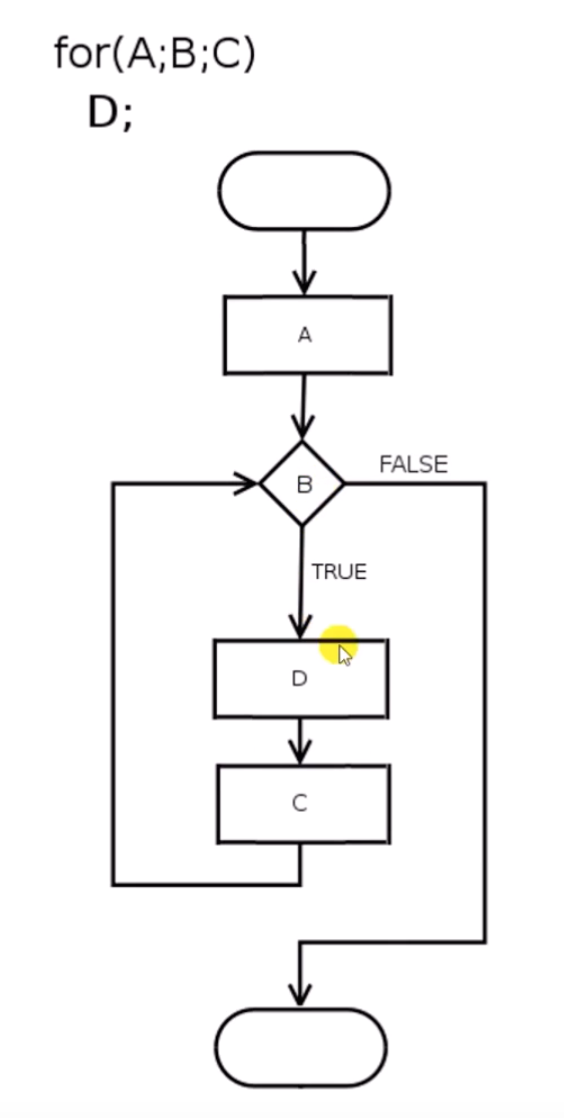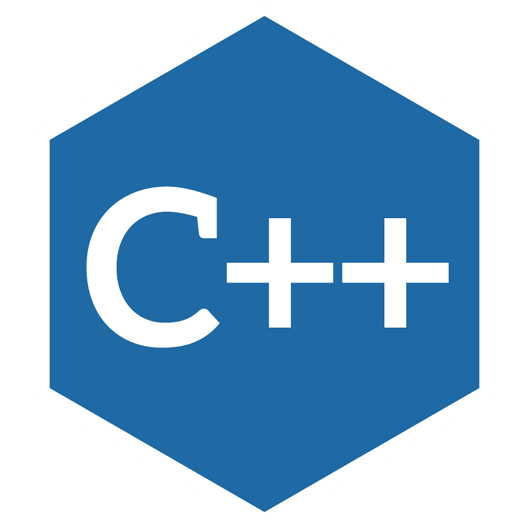제어 흐름 개요 Control flow
순서도 (Flow Chart)
 {:width="20%" height="20%"}
{:width="20%" height="20%"}
- 중단(Halt)
- 점프(Jump) : goto, break, continue
- 조건 분기(Conditional branches) : if, switch
- 반복(Loops) : while, do while, for
- 예외 처리(Exceptions) : try, catch, throw
조건문
if
- 설명
if문 문법 예제
#include <iostream>
int main() {
using namespace std;
int x, y;
cin >> x >> y;
if (x > 0 && y > 0)
cout << "both numbers are positive" << endl;
else if (x > 0 || y > 0)
cout << "one of the numbers is positive" << endl;
else
cout << "Neither number is positive" << endl;
return 0;
}
}
3
-2
one of the numbers is positive
switch
- 설명
switch 문 문법 예제
#include <iostream>
using namespace std;
enum class Colors
{
BLACK,
WHITE,
RED,
GREEN,
BLUE,
};
void printColorName(Colors color)
{
switch (static_cast<int>(color))
{
case 0 :
cout << "Black";
break;
case 1 :
cout << "White";
break;
case 2 :
cout << "Red";
break;
case 3 :
cout << "Green";
break;
case 4 :
cout << "Blue";
break;
default :
cout << "Undefined input ";
}
cout << endl;
}
int main() {
printColorName(Colors::BLACK);
return 0;
}반복문
while (조건)
조건이 참이면 다음에 나오는 { } 안에 문장 실행
문법 사용 예제
#include <iostream>
int main() {
using namespace std;
cout << "While-loop test" << endl;
int outer_count = 1;
while(outer_count <= 5)
{
int inner_count = 1;
while (inner_count <= outer_count)
{
cout << inner_count++ << " ";
}
cout << endl;
++outer_count;
}
return 0;
}While-loop test
1
1 2
1 2 3
1 2 3 4
1 2 3 4 5
do while
- 반복하기전에 반드시 한번은 실행해야 할 때 사용
do뒤에 { } 안에 문장 반복,while(조건)
문법 사용 예제
#include <iostream>
int main()
{
using namespace std;
int selection; // must be declared outsied do/while loop
do
{
cout << "1. add" << endl;
cout << "2. sub" << endl;
cout << "3. mult" << endl;
cout << "4. div" << endl;
cin >> selection;
} while (selection <= 0 || selection >= 5);
cout << "You Selected " << selection << endl;
return 0;
}for
- 뒤에 숫자가 와서 깔끔하게 정리 되는 경우에 많이 사용된다.
- while 문과 비교해보면 while은 반복횟수가 많을 때, for문은 반복횟수가 정해져있을때 사용하면 좋다
- 상호 변환이 가능하다
for(count로 샤용할 변수; 반복할 조건; 변수 증감이나 연산)
for문 문법 사용 예제
#include <iostream>
int pow(int base, int exponent)
{
int result = 1;
for (int count = 0; count < exponent; ++count)
{
result *= base;
}
return result;
}
int main()
{
std::cout << pow(2, 4) << std::endl;
// 구구단
for(int j = 1; j < 10; ++j)
{
std::cout << j <<"단 " << std::endl;
for(int i = 1; i < 10; ++i)
{
std::cout << j << " * " << i << " = " << (i*j) << "\t";
}
std::cout << std::endl;
}
return 0;
}점프
- 반복문을 제어하는 기법
break
- 실행중인 반복문 블럭에서 빠져나간다.
- 조건에 따라서 반복문을 더이상 진행시키지 않을 때 사용
break vs return 예제
#include <iostream>
void breakOrReturn()
{
while (true)
{
char ch;
std::cin >> ch;
if(ch == 'b')
break;
if(ch == 'r')
return;
}
std::cout << "Hello" << std::endl;
}
int main()
{
breakOrReturn();
return 0;
}
b를 누르면 Hello가 출력된다.
r을 누르면 Hello가 출력되지 않고 프로그램이 종료된다.
break 예제
#include <iostream>
int main()
{
using namespace std;
int count(0);
char ch;
while (true)
{
cout << "input x to escape" << endl;
cin >> ch;
cout << ch << " " << count << endl;
if (ch == 'x')
break;
}
return 0;
}
bool escape_flag변수를 만들어서if문 에서while의 조건을 변경 하는 방법도 있지만,break를 사용하면 더 간단하다.
continue
- 반복문 중 continue가 있으면 아래 구문을 실행하지 않고 다시 반복문 처음으로 돌아감
예제
#include <iostream>
int main()
{
for( int i = 0; i < 10; ++i)
{
if(i % 2 == 0) continue;
std::cout << i << std::endl;
// 같은문법
// if(i % 2 == 1)
// std::cout << i << std::endl;
}
return 0;
}위 아래 둘다 10 이전 홀수만 출력한다.
goto
- 잘 안씀, 옛날 문법
- label 이름을 정하기
goto 라벨명하면 라벨 위치로 돌아감
goto 문법 예제
#include <iostream>
#include <cmath> // sqrt()
int main() {
using namespace std;
double x;
tryAgain : // label
cout << "Enter a non-negative number" << endl;
cin >> x;
if (x < 0.0)
goto tryAgain;
cout << sqrt(x) << endl;
return 0;
}난수 생성
- 컴퓨터는 난수를 만들 능력이 없다.
난수 만드는(계산해내는) 코드 예제
#include <iostream>
using namespace std;
unsigned int PRNG() // Pseudo Random Number Generator
{
static unsigned int seed = 5523; // seed number
seed = 8253729 * seed + 2396403; // over flow occur
return seed % 32768;
}
int main() {
for (int count = 1; count <= 100; ++count)
{
cout << PRNG() << "\t";
if(count % 5 == 0) cout << endl;
}
return 0;
}
static변수와 overflow를 이용한 코드
1. 최초에 아무 숫자로나 초기화
2. 큰 수를 넣어서 overflow 발생 -> 이상한 숫자가 남음 (unsigned int type이라 음수는 안생김)
3. 이상하게 나온수의 나머지를 난수로 사용
4. 이상하게 나온수는 다시 seed로 사용
std::rand와std::srand를 이용하여 난수를 만들 수 있다.std::srand(숫자)는 seed number를 설정해준다.- seed number 가 일정하면 항상 같은 수를 내보낸다.
- 시간은 계속 변하기 때문에 시간을 seed number로 하는 난수를 생성하면 된다.
구현 예제
#include <iostream>
#include <cstdlib> // std::rand(), std::srand()
#include <ctime> // std::time()
using namespace std;
int main()
{
std::srand(static_cast<unsigned int>(std::time(0)));
for (int count = 1; count <= 100; ++count)
{
cout << std::rand() << "\t";
if(count % 5 == 0) cout << endl;
}
return 0;
}Random 라이브러리 활용
- 난수생성은 라이브러리를 활용하는게 가장 좋다.
사용 예제
#include <iostream>
#include <random>
int main()
{
std::random_device rd;
//create a mesenne twister,
std::mt19937_64 mersenne(rd()); // 64bit 짜리 난수
std::uniform_int_distribution<> dice(1, 6); // 1부터 6까지 동일한 확률로 나올수 있게 해준다.
for(int count = 1; count <= 20; ++count)
{
std::cout << dice(mersenne) << std::endl;
}
return 0;
}std::cin 더 잘 쓰기
- 사용자가 한 번에 여러개를 입력할 때 (한 개만 입력 받으려 했는데)
-cin은 여러개가 들어오면 하나만 받고 나머지는 buffer에 저장
-std::cin.ignore(적당한수, '\n')로 buffer 초기화 - 사용자가 의도하지 않은 이상한 문자를 입력할 때
-std::cin.fail()은 잘못된 문자 타입을 넣거나 저장공간을 초과하는 입력을 받았을 때true를 반환한다.
- 이를 이용하여 조건문으로 처리한다. std::clear()는 buffer에 남아있는 모든 데이터를 없앤다.
예제
#include <iostream>
using namespace std;
int getInt()
{
while(true){
cout << "Enter an integer number : ";
int x;
cin >> x;
if(std::cin.fail())
{
std::cin.clear();
std::cin.ignore(32767, '\n');
cout << "Invalid number, please try again" << endl;
}
else{
std::cin.ignore(32767, '\n');
return x;
}
}
}
char getOperator()
{
while (true){
cout << "Enter an operator (+, -) : "; // TODO: more operators *, / etc.
char op;
cin >> op;
std::cin.ignore(32767, '\n');
if(op == '+' || op == '-' )
return op;
else
cout << "Invalid operator, please try again" << endl;
}
}
void printResult(int x, char op, int y)
{
if (op == '+') cout << x + y << endl;
else if (op == '-') cout << x - y << endl;
else
{
cout << "Invalid operator" << endl;
}
}
int main()
{
int x = getInt();
char op = getOperator();
int y = getInt();
printResult(x, op, y);
return 0;
}

